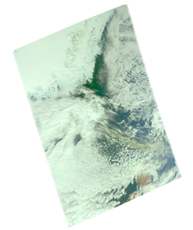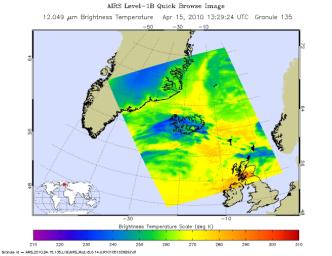
Inset
Click on the image for larger visible imageFor the second time this month, Iceland's Eyjafjallajökull volcano (pronounced "Aya-fyatla-jo-kutl") erupted on Wed., April 14, 2010, spewing a cloud of ash into the atmosphere that is disrupting air travel in Northern Europe and around the world.
The Atmospheric Infrared Sounder (AIRS) instrument on NASA's Aqua satellite flew over the volcano at 1:30 p.m. local time (13:29:24 UTC, or 6:29:24 a.m. PDT) on April 15, capturing this false-color infrared image (top) and visible image (inset) of the ash plume. The image shows the ash cloud being carried over the Shetland Islands and onward to Europe. The ash clouds appear to be at an altitude of 3,658 meters (12,000 feet).
NASA works with other agencies on using satellite observations to aid in the detection and monitoring of aviation hazards caused by volcanic ash. For more on this NASA program, visit http://science.larc.nasa.gov/asap/research-ash.html. The ingestion of ash particles from such clouds can result in engine failure for aircraft.
Infrared Images
Because infrared radiation does not penetrate through clouds, AIRS infrared images show either the temperature of the cloud tops or the surface of Earth in cloud-free regions. The lowest temperatures (in purple) are associated with high, cold cloud tops. In cloud-free areas the AIRS instrument will receive the infrared radiation from the surface of the Earth, resulting in the warmest temperatures (orange/red).
Visible/Near-Infrared Images
The AIRS instrument suite contains a sensor that captures radiation in four bands of the visible/near-infrared portion of the electromagetic spectrum. Data from three of these bands are combined to create "visible" images similar to a snapshot taken with your camera.
About AIRS
The Atmospheric Infrared Sounder, AIRS, in conjunction with the Advanced Microwave Sounding Unit, AMSU, senses emitted infrared and microwave radiation from Earth to provide a three-dimensional look at Earth's weather and climate. Working in tandem, the two instruments make simultaneous observations all the way down to Earth's surface, even in the presence of heavy clouds. With more than 2,000 channels sensing different regions of the atmosphere, the system creates a global, three-dimensional map of atmospheric temperature and humidity, cloud amounts and heights, greenhouse gas concentrations, and many other atmospheric phenomena. Launched into Earth orbit in 2002, the AIRS and AMSU instruments fly onboard NASA's Aqua spacecraft and are managed by NASA's Jet Propulsion Laboratory in Pasadena, Calif., under contract to NASA. JPL is a division of the California Institute of Technology in Pasadena.
More information about AIRS can be found at http://airs.jpl.nasa.gov.

 Planetary Data System
Planetary Data System













